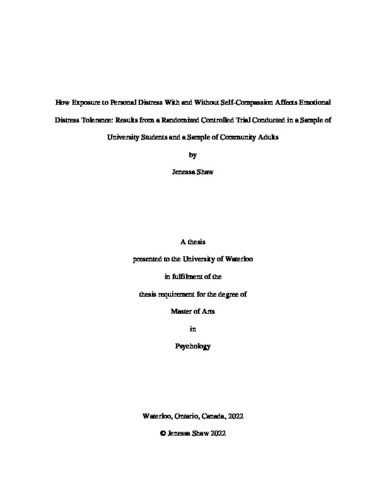| dc.description.abstract | Emotional distress tolerance refers to the perceived ability to tolerate one’s negative emotions (Simons & Gaher, 2005). Low emotional distress tolerance is a transdiagnostic marker of psychopathology (Leyro et al., 2010) and is therefore important to target in psychological interventions. Cognitive behavioural theories suggest that to overcome low emotional distress tolerance, individuals need to expose themselves to their negative emotions and, in so doing, learn that experiencing negative emotions is more tolerable than they expected. However, when distress intolerant individuals participate in therapy involving such exposures, they find them unbearable (Belleau et al., 2017; Griffen et al., 2018) and terminate treatment early (Daughters et al., 2005; Niles et al., 2017). We theorized that self-compassion, which involves enacting a caring, curious stance toward one’s own distress with the intention of preventing and alleviating it (Gilbert, 2014), might make the experience of feeling negative emotions more bearable due to its soothing physiological effects (Kim et al., 2020). We therefore tested the primary hypothesis that, among individuals low in emotional distress tolerance, exposure to negative emotions with self-compassion, as compared to without and a placebo control condition, would lead to superior emotional distress tolerance and that this effect would occur indirectly via greater levels of soothing affect. We also sought to test the secondary hypotheses that exposure with self-compassion compared to without would have higher treatment acceptability and lead to less emotional avoidance over time. To test these hypotheses, we conducted a randomized, single-blind, placebo-controlled, three-arm, parallel-group, additive, superiority trial in a Canadian student sample (n = 126) recruited through a mid-sized Canadian university’s participant pool and an international community sample (n = 298) recruited through the Prolific participant pool, both of which comprised fluent English-speaking adults with below-average levels of emotional distress tolerance. In an online session, participants were asked to recall a distressing situation and then were randomly assigned through the randomizer function within Qualtrics at a ratio of 1:1:1 to perform one of three written tasks involving: 1) exposure to negative emotions (student sample n = 42, community sample n = 100); 2) exposure to negative emotions with self-compassion (student sample n = 43, community sample n = 98); or 3) a control distraction-based planning condition (student sample n = 41, community sample n = 100). Participants completed questionnaires immediately before and after their written intervention task and again one week later. ANCOVAs revealed that, controlling for baseline emotional distress tolerance levels, condition significantly predicted emotional distress tolerance levels immediately post-intervention, n2p = .02-.06. The exposure with self-compassion condition yielded higher post emotional distress tolerance than the pure exposure condition in both the student sample (d = 0.52) and community sample (d = 0.37). Further, in both samples, increased soothing affect during the intervention significantly mediated 65-67% of the effect of condition on post-intervention emotional distress tolerance levels. However, ANCOVAs also revealed that, controlling for baseline emotional distress tolerance levels, condition did not significantly predict emotional distress tolerance levels at the one-week follow-up, n2p = .02-.03. Further, results did not support our hypotheses that the self-compassion condition would result in greater treatment acceptability and emotion engagement. Although not all our hypotheses were supported, results across samples support a focus on helping individuals low in emotional distress tolerance to cultivate self-compassion when experiencing negative emotions. It seems that the soothing affect self-compassion promotes may help these individuals to learn that feeling their distress is more tolerable than they had anticipated. This study is registered with the US Clinical Trials Registry #NCT05284578 and was funded by SSHRC Insight Grant 435-2017-0062. | en |

